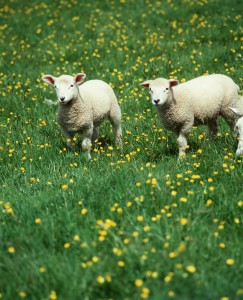 It’s all about grass at the moment, growing it, cutting it and conserving it.
It’s all about grass at the moment, growing it, cutting it and conserving it.
Above us, the sun is shining, the skylarks are singing and it’s beautiful. On the ground the grass is either lying in neat rows waiting for Tim to bale it up today, spread out to dry, or still waiting to be cut.
Grass is our most important crop at Higher Hacknell Farm, as we are a stock rearing farm and all our lamb and beef are grass fed. You’ve probaly read or heard people saying ‘grass fed’ beef is the healthiest and tastiest to eat and there are alot of learned papers with the fact and figures. As far as we are concerned, it’s just common sense and natural for livestock to eat grass, especially here in Devon where it grows so well. So, it doesn’t come as any surprise to us that grass fed animals also make the best tasting meat. And it is obviously better for the environment that we grow our feed here on the farm rather than buy it in in concentrate feed from the other side of the world and then not really know what we are putting into our animals.
In a letter recently to the Farmers Weekly, Peter Melchett, the Soil Association’s Policy Director wrote:
“Grass-fed cattle and sheep avoid the damaging impacts of imported animal feed, while helping to store carbon in UK grassland and rough grazing. People outside farming tend to ignore the huge differences in the ways in which livestock is produced. The feed that goes to intensive chickens and pigs, or to high yielding dairy and beef, gives a completely different environmental impact when compared to free-range and organic poultry or pork fed largely on home-grown feed or soya imported from countries like Italy. Grass-fed, native breeds of cattle cannot be compared, in terms of taste or environmental impact, with feed-lot beef.”
Farmers Weekly (14 May, p.31)
Although to most people, grass is just grass,to us organic farmers, it means everything! We have many varieties, different seed mixtures, all for specific purposes. Some, like the red clover and rye grass grow quickly and make good quality silage, while the permanent pastures have a huge diversity of mainly native grasses and herbs, and grow slower, but make sweet smelling soft hay. We have a mixture of short, medium and long term leys here at Higher Hacknell Farm which means some fields are ploughed every three to five years in rotation with growing crops such as barley and wheat. These are the short term leys which produce the high yielding ,good quality grass for feeding to the fat cattle, whereas the permanent pastures are never ploughed and used for grazing and for hay. One of my favourite pastures here is the old parkland next door to the Northcote Manor, with a stunning copper beach tree in it and the field above it, we call The Beeches, is laid up now for making hay. When I walked through there with my spaniel puppy the other day, Tim pointed to his bright yellow legs which were completely stained by the mass of buttercups he’d run through and knew exactly where we’d been!
The tractors are going up and down the lane with trailers of bales to be wrapped and stacked, and then onto the next field, to row up and bale. There are still more fields to mow and we’ve got to keep it going while the weather is with us and get the grass conserved for winter, which happily seems a long way off!